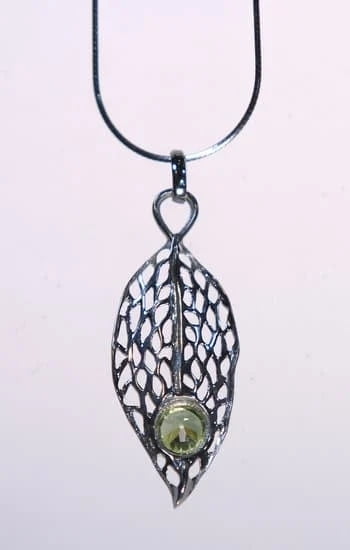For centuries, the Silk Road served as a significant trade route that connected East and West, enabling the exchange of ideas, goods, and cultures between China and other regions. Amidst this ancient network of paths and trails lay a treasure trove of exquisite Chinese jewelry, crafted with unparalleled skill and reflecting the rich cultural heritage of China.
From jade ornaments to gold accessories, each piece tells a captivating tale of craftsmanship, symbolism, and historical significance. In this article, we embark on a fascinating journey through time to explore the enduring legacy of Chinese jewelry on the Silk Road.
The Silk Road was much more than just a physical route; it represented a bridge between civilizations and an avenue for cross-cultural exchange. Originating in ancient China during the Han Dynasty (206 BCE – 220 CE), this legendary trade route stretched across Asia, traversing numerous countries such as Mongolia, India, Persia, and eventually reaching Europe. Along this arduous path emerged an intricate web of commercial activity that fueled economic growth while also fostering intercultural connections.
Chinese jewelry holds a special place in this narrative of cross-continental commerce. Not only did it serve as an object of personal adornment but also acted as a symbol of wealth, status, and cultural identity.
Chinese craftsmen perfected techniques passed down through generations to create stunning pieces that captivated both locals and foreign traders alike. Each gemstone meticulously carved or intricately woven into precious metals conveyed not only aesthetic beauty but also deep-rooted cultural symbols inherent in Chinese society.
As we delve into the annals of history along the Silk Road, we will explore how Chinese jewelry evolved over time from its humble beginnings in ancient China to becoming highly sought after throughout various civilizations. We will uncover the unique types and styles of jewelry that adorned men and women alike along this iconic trade route.
Moreover, we will examine how influences from neighboring cultures and foreign traders shaped the artistry of Chinese jewelry while preserving its original charm. Join us on this expedition, and immerse yourself in the luxurious legacy of Chinese jewelry that prevailed on the Silk Road.
Understanding the Silk Road
The Silk Road was an ancient trade route that played a crucial role in connecting the East and West, enabling the exchange of goods, ideas, and cultures. Stretching over 6,000 miles, this historical network of routes extended from China in the east to the Mediterranean Sea in the west.
The Silk Road derived its name from the lucrative trade of Chinese silk that flourished along its route. However, silk was just one of many commodities that were traded, and jewelry also held a significant place in this vibrant exchange.
The Silk Road facilitated not only trade but also cultural exchange between different civilizations. It allowed for the movement of people, ideas, and technologies, leading to a fusion of artistic styles and techniques. As a result, Chinese jewelry on the Silk Road reflects influences from various cultures such as Indian, Persian, Central Asian, Greco-Roman, and more.
Chinese jewelry found along the Silk Road is characterized by its exquisite craftsmanship and cultural significance. From gold earrings to jade pendants, these pieces were created with meticulous attention to detail and reflected the wealth and status of their owners. Jewelry served both decorative and symbolic purposes in ancient China. It was worn as a form of personal adornment but also signified social status and religious beliefs.
| Chinese Jewelry Types | Description |
|---|---|
| Jade | Considered as the most sought-after gemstone on the Silk Road; symbolized nobility and luxury. |
| Gilded Silver | Highly valued for its aesthetic appeal; often used for creating intricate adornments. |
| Enamel | Popular technique used in Chinese jewelry; added vibrant colors and intricate patterns to pieces. |
| Pearls | Symbolized purity and elegance; widely used in creating necklaces, earrings, and hair ornaments. |
As the Silk Road provided a platform for cultural exchange, Chinese jewelry began to showcase influences from other civilizations. For example, the inclusion of Buddhist motifs became prominent during the Tang Dynasty (618-907). Furthermore, the Islamic cultural influence can be seen through the use of Arabic calligraphy and Islamic symbols such as crescents and stars.
Overall, understanding the Silk Road is essential when exploring the history of Chinese jewelry. The trade route serves as a gateway into the rich cultural heritage of China and its interactions with other civilizations. From jade to gilded silver, Chinese jewelry on the Silk Road represents centuries of craftsmanship, symbolism, and artistic fusion.
Chinese Jewelry
Chinese jewelry is not just a beautiful adornment; it is a testament to the exquisite craftsmanship and rich cultural heritage of China. The artistry and attention to detail that goes into each piece of Chinese jewelry reflect the deep traditions and values of the Chinese people. From ancient times to the present day, Chinese jewelry has played an integral role in society, symbolizing wealth, status, and cultural identity.
The craftsmanship that goes into creating Chinese jewelry is truly remarkable. Skilled artisans meticulously handcraft each piece with precision and expertise, using techniques that have been passed down through generations. Intricate filigree work, delicate carving, and intricate enamel work are just some of the techniques employed in creating Chinese jewelry. These designs often incorporate auspicious symbols from Chinese mythology and folklore, such as dragons, phoenixes, and mythical creatures like qilin.
Chinese jewelry also holds great cultural significance for the Chinese people. It serves as a way to express one’s personal style while also honoring traditional customs. For example, during important festivals and celebrations like weddings or New Year’s festivities, wearing gold or jade jewelry is believed to bring good luck and ward off evil spirits. In addition to its symbolic meaning, Chinese jewelry also carries sentimental value as family heirlooms are often passed down through generations.
Examples of Chinese Jewelry
– Yǔ’èrbā – A type of traditional hairpin adorned with gemstones or pearls.
– Bǎoshí – Necklaces made with precious stones like jade or coral.
– Dānghuán – Symbolic bracelets often worn by married women.
– Guàzi – Earrings made with precious metals like gold or silver.
The craftsmanship involved in creating these pieces reflects the skill and dedication of Chinese artisans throughout history. Whether ornate or minimalistic in design, each piece of Chinese jewelry tells a unique story and is a testament to the rich cultural heritage of China. The importance of Chinese jewelry extends beyond mere decoration; it is a tangible link to a bygone era and a way to preserve tradition for future generations.
The Beginnings of Chinese Jewelry
Chinese jewelry has a long and rich history, with its origins dating back to ancient China. The ancient Chinese people had a deep appreciation for beauty and craftsmanship, and this is evident in the exquisite jewelry that they created. The beginning of Chinese jewelry can be traced back to the Neolithic period, around 5000 BC.
During this period, the people of ancient China started using natural materials such as stones, bones, shells, and animal teeth to create jewelry. These materials were often carved or shaped into beautiful ornaments that were worn as accessories. As time went on, the Chinese developed new techniques for jewelry making and began using more precious materials such as gold and silver.
One of the key characteristics of ancient Chinese jewelry is its symbolism. In ancient Chinese culture, certain symbols held significant meaning and were believed to bring good luck and fortune. For example, jade was considered a sacred stone and was associated with immortality. It was often used in jewelry to symbolize purity, wisdom, and power.
The art of jewelry making in ancient China reached its peak during the Han Dynasty (206 BC – 220 AD). This period saw the emergence of sophisticated techniques such as filigree work, granulation, enameling, and cloisonné. Goldsmiths and silversmiths became highly skilled craftsmen who created intricate pieces of jewelry adorned with gemstones and pearls.
| Period | Key Characteristics |
|---|---|
| Neolithic period (5000 BC) | Use of natural materials like stones, bones, shells |
| Han Dynasty (206 BC – 220 AD) | Sophisticated techniques like filigree work; use of gemstones and pearls |
The jewelry created during this time not only served as adornments but also as status symbols. It was worn by both men and women to display their wealth, social status, and taste. Ancient Chinese society had strict hierarchies, and the type of jewelry one wore often indicated their position in society.
Treasures Unveiled
The Silk Road was not only a trading route for silk and other valuable goods, but also a corridor that facilitated the exchange of various types of jewelry. The diverse types of Chinese jewelry found along this ancient trade route reflect the rich history and cultural significance of both China and the regions it connected with.
One type of Chinese jewelry that captivated traders and travelers along the Silk Road was gold ornaments. The prosperity of ancient China allowed for skilled craftsmen to create intricate designs and intricate details on gold jewelry pieces.
Gold was considered a symbol of wealth and social status, so it’s no surprise that many pieces were adorned with precious gemstones like rubies, sapphires, jade, and pearls. These exquisite gold ornaments were often worn as both decorative accessories and symbols of power.
Another type of Chinese jewelry that flourished along the Silk Road was silver jewelry. Silver had a special place in Chinese culture, associated with purity and warding off evil spirits. Intricate silver necklaces, bracelets, earrings, and rings were crafted with regional styles and techniques. Some pieces featured elaborate filigree patterns, while others showcased symbolic motifs like dragons or mythical creatures.
Chinese turquoise jewelry also gained popularity along the Silk Road. Turquoise was highly valued for its vibrant blue-green hue believed to bring good luck and protection from harm. Tibetan influence led to unique designs incorporating turquoise beads in necklaces, earrings, bracelets, and rings. These eye-catching pieces became highly sought after by traders who traveled along the Silk Road.
| Type of Chinese Jewelry | Description |
|---|---|
| Gold Ornaments | Intricate designs adorned with precious gemstones like rubies, sapphires, jade, and pearls. |
| Silver Jewelry | Elaborate necklaces, bracelets, earrings, and rings crafted with regional styles and techniques. |
| Turquoise Jewelry | Unique designs incorporating turquoise beads believed to bring good luck and protection from harm. |
Jade
Jade has long been considered the most prized gemstone along the Silk Road and holds significant symbolism in Chinese jewelry. Revered for its beauty, durability, and cultural significance, jade has played a central role in Chinese traditions for thousands of years.
The Significance of Jade in Chinese Culture
In Chinese culture, jade is believed to possess various qualities that make it highly valued. It is considered a symbol of purity, grace, and nobility. Furthermore, jade is associated with good luck, prosperity, and longevity. Because of its association with these positive attributes, jade has been an important material in creating jewelry throughout China’s history.
Historical Importance of Jade along the Silk Road
Jade holds a special place in the history of the Silk Road as it was one of the most widely traded commodities along this ancient trade route. The Silk Road acted as a channel for not only goods but also cultural exchange between diverse civilizations. Jade from China was highly sought-after by traders traveling along the Silk Road due to its quality and craftsmanship.
Chinese jade jewelry found along the Silk Road showcases exquisite workmanship and unique designs. These artifacts reflect both traditional Chinese styles and influences from other cultures that were encountered on this international trade route.
Jade Symbolism in Chinese Jewelry
Jade was used to create various types of jewelry such as necklaces, bracelets, earrings, and decorative items like hairpins and pendants. Each piece held deep symbolism depending on its design and motifs. For example, a dragon carved from jade represents power and authority while a lotus flower signifies purity and enlightenment.
The color of jade also holds significance in Chinese culture. Green jade symbolizes fertility and harmony while white jade represents modesty and integrity. Additionally, with its translucent nature allowing light to pass through it beautifully, jade is often associated with spiritual enlightenment.
Cultural Exchange and Influences
The Silk Road was not only a trade route, but also a pathway for cultural exchange between different civilizations. Chinese jewelry played a significant role in this exchange, as it not only showcased the exquisite craftsmanship of the ancient Chinese, but also incorporated influences from other cultures along the Silk Road.
One notable influence on Chinese jewelry was from the Central Asian nomadic tribes, such as the Scythians and Sarmatians. These nomadic groups brought their own unique style and techniques to Chinese jewelry making. One of the most notable examples of this is the use of animal motifs in jewelry design, particularly depictions of animals such as horses, deer, and birds. This influence can be seen in the intricate animal-shaped pendants and ornaments found in ancient Chinese tombs.
Another major influence on Chinese jewelry came from India. The introduction of Buddhism to China through the Silk Road brought with it new styles and symbols that were reflected in jewelry design. One such example is the use of lotus flower motifs, which symbolize purity and enlightenment in Buddhist culture. The lotus flower became a popular motif in Chinese jewelry and can be found on earrings, pendants, and hair ornaments.
The Persian Empire also had a significant impact on Chinese jewelry. Persian craftsmen were known for their expertise in goldsmithing and gemstone cutting, which greatly influenced Chinese jewelers. The use of precious metals such as gold and silver became more prevalent in Chinese jewelry during this time. Additionally, Persian motifs like grapevines and floral patterns were adopted into Chinese designs.
Women as Adornments of Fashion and Wealth
Chinese Jewelry as Status Symbols
In ancient Chinese society, jewelry played a crucial role in defining a woman’s status and social standing. The display of elaborate and exquisite jewelry was not only a symbol of wealth but also represented power, prestige, and femininity. Women adorned themselves with an array of jewelry pieces to showcase their family’s prosperity and enhance their own beauty.
During the Tang Dynasty (618-907 AD), for example, women from the upper classes wore intricate gold necklaces, jade pendants, pearl earrings, and ornate hairpins adorned with gemstones. These accessories were not only considered fashionable but also carried deep symbolism. The choice of gemstones like jade or pearls reflected the wearer’s virtue and purity, while gold represented status and wealth.
The Symbolic Meanings Behind Chinese Jewelry
Chinese jewelry is deeply steeped in symbolism, with each piece carrying significant meaning. For instance, the butterfly motif was often seen in Chinese jewelry during the Ming (1368-1644) and Qing (1644-1912) dynasties. In Chinese culture, butterflies represent joy and happiness. Consequently, butterfly-shaped pendants or earrings were popular choices to accentuate a woman’s beauty and bring good fortune.
Another prominent symbol in Chinese jewelry is the dragon. Dragons are revered creatures in Chinese mythology associated with power, strength, and good luck. Dragon motifs can be found on various types of jewelry such as rings, bracelets, and hairpins. Wearing dragon-themed jewelry was believed to bring protection against evil spirits and ensure success in all endeavors.
Jewelry as Adornments of Fashion
Beyond its symbolic significance, Chinese jewelry was also an essential fashion accessory in ancient society. Women took great care in matching their outfits with appropriate jewelry pieces to create stunning ensembles that showcased their taste for fashion.
For example, during the Ming Dynasty, the popularity of intricate hairpins reached its peak. These hairpins were not only used to secure elaborate hairstyles but also adorned with gemstones, jade carvings, or filigree designs. The choice of hairpin design and materials varied depending on the occasion and the woman’s social status.
Additionally, bracelets and anklets made from gold or precious gemstones were commonly worn by women as a fashion statement. These bold accessories added glamour and elegance to their outfits, making them stand out in social gatherings.
Overall, Chinese jewelry served as both a symbol of wealth and social standing while also providing an opportunity for women to showcase their personal style and fashion sense. Its exquisite craftsmanship and deep cultural significance continue to captivate people around the world, making it a timeless treasure from the Silk Road era.
Decline and Revival
The decline of the Silk Road had a significant impact on the Chinese jewelry trade. As the trade route began to disintegrate in the 14th century, access to precious materials and markets for Chinese jewelry became limited. This led to a decline in the production and distribution of Chinese jewelry, as well as a loss of cultural exchange and influences between different Silk Road cultures.
The Loss of Access to Precious Materials
One of the major consequences of the Silk Road’s decline was the loss of access to precious materials that were crucial for Chinese jewelry-making. The Silk Road served as a vital trading network for gemstones, such as turquoise, lapis lazuli, and coral, which were used extensively in Chinese jewelry.
With the disruption of trade routes, obtaining these gemstones became increasingly difficult and expensive. As a result, Chinese jewelers had to rely more heavily on locally available materials, such as jade and gold, which influenced the design and aesthetic of their pieces.
A Decline in Cultural Exchange
The disintegration of the Silk Road also meant a decline in cultural exchange between different civilizations along the route. Before its decline, the Silk Road allowed for an exchange of ideas, techniques, and artistic styles among various cultures, including China. These exchanges often influenced the design and craftsmanship of Chinese jewelry. However, with declining trade activities came a reduced opportunity for contact and interaction between different cultures, leading to a stagnation in creativity within Chinese jewelry-making.
The Revival: Rediscovering Ancient Techniques
Despite the challenges brought about by the decline of the Silk Road, there was eventually a revival of interest in Chinese jewelry-making during Ming dynasty (1368-1644). This period saw a resurgence in craftsmanship and creativity as artisans began rediscovering ancient techniques that had been lost or neglected during times of limited trade.
Ming-era jewelers drew inspiration from archaeological discoveries and ancient texts, infusing traditional Chinese motifs and symbols into their designs. This revival not only reinvigorated the Chinese jewelry trade but also sparked a renewed interest in preserving and promoting the cultural heritage associated with it.
The decline of the Silk Road had a lasting impact on the Chinese jewelry trade, from a loss of access to precious materials to a decline in cultural exchange. However, amid these challenges, the trade eventually experienced a revival during the Ming dynasty, thanks to a rediscovery of ancient techniques and an infusion of traditional motifs into contemporary designs.
The legacy of Chinese jewelry from the Silk Road continues to endure today, captivating collectors and enthusiasts alike with its exquisite craftsmanship and rich cultural significance.
Legacy and Modern Adaptations
Chinese jewelry from the Silk Road holds a significant place in history and continues to captivate people today with its enduring appeal. The legacy of Chinese jewelry on the Silk Road is not only limited to the past but also encompasses modern adaptations that keep this rich tradition alive. This section will delve into the reasons behind the enduring appeal of Chinese jewelry and explore how it has evolved and adapted over time.
One reason for the lasting popularity of Chinese jewelry from the Silk Road is its exquisite craftsmanship. Throughout history, Chinese artisans have been renowned for their meticulous attention to detail and mastery of various techniques. These skills are evident in the intricate designs and fine workmanship found in ancient Chinese jewelry. Today, modern artisans still draw inspiration from these traditional techniques, creating contemporary pieces that pay homage to the ancient artistry.
Another factor contributing to the enduring appeal of Chinese jewelry is its cultural significance. In Chinese culture, jewelry has always held symbolic meaning beyond mere ornamentation. Different materials used in Chinese jewelry carry specific symbolism, such as jade symbolizing longevity and prosperity, while gold represents wealth and success. These cultural meanings embedded within Chinese jewelry make it more than just decorative accessories; they become cherished heirlooms that hold profound meaning for generations.
The influence of Chinese jewelry from the Silk Road has also extended beyond China itself. As trade along the Silk Road flourished, cultural exchange occurred, resulting in a fusion of styles and techniques. This cross-pollination can be seen in the incorporation of gemstones like turquoise, carnelian, and lapis lazuli from Central Asia into traditional Chinese designs. Such intermingling of cultures not only enriched ancient Chinese jewelry but also played a significant role in shaping global fashion trends.
Conclusion
Throughout history, the Silk Road has played a pivotal role in connecting civilizations and facilitating trade between East and West. In this article, we have delved into the rich history of Chinese jewelry on the Silk Road, exploring its origins, significance, and enduring appeal. As we conclude our exploration, it is clear that Chinese jewelry holds a luxurious legacy that continues to captivate us today.
Chinese jewelry is not only a testament to exquisite craftsmanship but also a reflection of cultural identity. Through the diverse types of jewelry discovered along the Silk Road, we catch a glimpse of how different dynasties and regions in ancient China expressed their unique aesthetic sensibilities. The intricate designs, delicate filigree work, and vibrant gemstones showcased in Chinese jewelry speak volumes about the skills and creativity of artisans through the ages.
One gemstone that stands out in Chinese jewelry is jade, symbolizing purity, grace, and wisdom. Its significance on the Silk Road extends beyond its inherent beauty; jade served as a powerful emblem of status and wealth for both men and women. The widespread popularity of jade along this ancient trade route highlights not only its physical attributes but also its connection to spiritual beliefs and practices.
The interaction between Chinese jewelry and other cultures along the Silk Road brought about a fascinating exchange of ideas and influences. From turquoise from Central Asia to Buddhism-inspired motifs from India, these cross-cultural encounters enriched Chinese jewelry designs with new materials, techniques, and symbolic meanings. This fusion of styles testifies to the interconnectedness of civilizations during this era.
Despite the decline of the Silk Road as a major trading route over time, Chinese jewelry has managed to endure through revived interest and modern adaptations. Today, designers draw inspiration from historical pieces found along this ancient route to create contemporary masterpieces that pay homage to their cultural heritage. This enduring appeal reflects our ongoing fascination with the opulence and allure of Chinese jewelry.
In conclusion, exploring the luxurious legacy of Chinese jewelry on the Silk Road is not only a journey through time but also an appreciation of the remarkable craftsmanship, cultural significance, and enduring beauty it represents. From its origins in ancient China to its interactions with other Silk Road cultures, Chinese jewelry has left an indelible mark on history.
As we immerse ourselves in its intricate designs and captivating stories, we gain a deeper understanding of the undeniable allure of this ancient art form.

Welcome to my jewelry blog! My name is Sarah and I am the owner of this blog.
I love making jewelry and sharing my creations with others.
So whether you’re someone who loves wearing jewelry yourself or simply enjoys learning about it, be sure to check out my blog for insightful posts on everything related to this exciting topic!





